| 18.00 Megapixels | Canon EF, EF-S | 3.0 inch LCD |
|---|---|---|
Canon EOS 60D
Overview
by Shawn Barnett, Dave Etchells, Mike Tomkins, and Zig WeidelichPreview Date: August 26, 2010
At long last Canon introduces the EOS 60D, its latest prosumer digital SLR. Coming into a world where digital SLRs can be seen gracing the neck of anyone who might have ever thought of being a photographer, it's not surprising that Canon has rethought its entry-level prosumer digital SLR. The new design is slightly smaller, and more specifically aimed at the advanced amateur market, better fitting into the niche occupied by the Nikon D90, while the Canon 7D is a better match for the Nikon D300S, cameras that are aimed more toward those making money with their photographs. The redesign still mostly adds and improves features, like the 18-megapixel sensor, Full HD Movie mode, and Vari-angle LCD, but there's at least one feature deletion that is a little frustrating, which we'll get to shortly.
We'd begun to wonder whether Canon would introduce another semi-Pro digital SLR in this price range, as it's been two years since the 50D debuted. But the 50D was introduced six months early, only one year from the 40D's announcement, so the 60D marks a return to the original schedule, and we don't expect an upgrade for another 18 months.
In past reviews, we've noted that Nikon had Canon SLRs bracketed, introducing SLRs that didn't quite compete directly with Canon's models in price or features, and that was no more true than when the Canon 50D was left to duke it out with both the Nikon D80/D90 and the Nikon D300/D300S. With the 7D now in place to take on the D300S, the Canon 60D is now aimed more directly at the Nikon D90, losing a few of its pro features in favor of a more consumer-driven focus and a smaller body.
The upgrade to an 18-megapixel sensor brings the Canon EOS 60D up to date with the Rebel T2i and the 7D, and splits the difference between the two in frame rate, with the T2i shooting 3.7 fps, and the 7D ripping through 8 fps, while the Canon 60D can shoot at 5.3 frames per second. That's down from the 50D's 6.3 frames per second, one of the first downgrades on the list.
A major improvement is the addition of a 1.04-million pixel, 3-inch Vari-angle LCD screen on the Canon 60D, opening up more unique composition possibilities to the class of shooter that Canon is seeking with this new design.
Though it's the sixth EOS SLR to support HD video capture, the Canon 60D is the first of its class to do so. Resolutions include 1,920 x 1,080p, 1280 x 720, and 640 x 480, saved in H.264 compression with linear PCM audio. Frame rates include 30, 25, and 24 fps for Full HD, and 60 fps and 50 fps for HD and VGA. Also included is a feature only recently added to the 5D Mark II's video mode, the all-important audio-level adjustment; so in this sense, the Canon 60D is a more advanced video capture device than the 7D.
Other basic specs on the Canon 60D include an ISO range from 100 to 6,400, plus a high setting for 12,800; a 63-zone dual-layer metering sensor; a 9-point all-cross-type phase-detect autofocus sensor; 100,000-cycle shutter durability; and shutter speeds from 30 to 1/8,000 second. Electronic leveling first seen in the 7D also makes its way into the Canon 60D, indicating pitch and roll like an airplane's attitude indicator. Compact flash has been replaced with SDXC compatibility, and the Canon 60D uses the same battery as the 7D.
A great many of the Canon 60D's controls have been pared down, and most buttons no longer have a dual purpose depending on the mode. Even the four top buttons that used to control two functions via the Main dial and the rear Quick Control dial are now dedicated to just one function per button. In this sense, the Canon 60D is more like a large Rebel with an LCD status display on the top deck than an evolution of the xxD line. Another, more welcome change integrates the 8-way joystick with the Quick Control dial. The major unfortunate omission to our minds is the Lens AF Microadjustment Custom Function, a software feature that anyone who cares about sharp images will want in their semi-pro camera. It's another example of how the Canon 60D is now aimed at the advanced amateur, not the semi-pro market.
Finally, you can use the Canon 60D's built-in flash to wirelessly remote control other Canon wireless EX flashes.
In another challenge to the Nikon D90, the Canon 60D will ship with the EF-S 18-135mm IS kit lens instead of the rather long-in-the-tooth EF 28-135mm IS lens that shipped with the 40D and 50D.
Scheduled for delivery toward the end of September, the Canon 60D comes in a kit with the 18-135mm f/3.5-5.6 IS zoom lens for US$1,399.00, and body only for US$1,099.00.
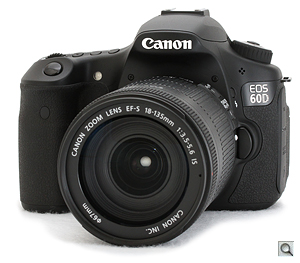 Canon EOS 60D
Canon EOS 60D
Hands-on Preview
by Shawn Barnett and Mike TomkinsThe long-awaited Canon EOS 60D comes with some incremental upgrades, a few unexpected losses, and some nice surprises; what was not a surprise was its easy and straightforward operation for one already familiar with cameras in this prosumer line, and excellent image quality across the ISO range.
As mentioned in the overview, the Canon 60D has a few more consumer-friendly features to go along with its consumer-friendly design. In addition to the Scene modes that have always accompanied this level of SLR, Canon now includes many image and video editing features right in the camera. Much of what was introduced in the 7D, including the color-detecting metering system and leveling features, made it into the Canon 60D, but along with those changes came a simplification of controls and a downsizing of the camera body. The one feature unique to the EOS 60D among Canon's SLRs is the Vari-angle LCD, brought over from the PowerShot line.
Look and feel. Anyone who thought the 50D was a little too bulky will appreciate the Canon 60D's smaller size. Apparent body-only weight has increased by 0.88 ounce (25g) to 26.6 ounces (1.66 pounds, 755g), likely due to the swivel screen. The body is made of a mixture of ABS resin, polycarbonate resin, and polycarbonate resin with a special conductive fiber, presumably for EMI (electromagnetic interference) shielding. The frame is aluminum and polycarbonate enhanced with glass fiber. Dimensions are 5.6 x 4.1 x 3.1 inches (144 x 105 x 78mm), a little bit shorter and less wide than the 50D, and just a bit thicker overall from the lens mount to the LCD thanks largely to the swiveling LCD.
Canon did not detail just how many environmental seals that the EOS 60D has, but they did say that it is a "robust, densely packed compact body with dust and water resistance." As you can see in the two diagrams at right, the EOS 60D's sealing is fairly extensive.
The grip is smaller, with a nice indentation just inside the grip to help improve your hold, something we've long appreciated in Nikon SLR designs. It's less noticeable from the front, but there's still an indentation for the middle finger to quickly align your hold.
Also in that indentation you'll find the infrared remote control window, something that's long been absent on the 60D's predecessors, yet included on the digital Rebels. Indeed, the omission dates all the way back to the original Canon consumer digital SLR, the D30, introduced in 2000.
Upper right of the lens mount are four holes for the new mono microphone. A stereo microphone jack is also built into the Canon EOS 60D for better quality movie recording.
From the top you see the nice EF-S 18-135mm f/3.5-5.6 IS lens, equivalent to a 28.8-216mm lens on a full-frame 35mm camera. Note that the lens is not USM (ultrasonic motor) drive, so it makes a little noise while focusing, unlike the 28-135 that was bundled with the 50D. The Mode dial on the left shoulder is a little different. First it omits the longstanding A-DEP setting that most people probably didn't use (it allows you to set your desired depth of field using AF points), and second, there's a button in the middle that you use to unlock the Mode dial. This is not new to EOS, but it is new to their digital SLRs (my old EOS Elan had a locking Mode dial). Many will love it, many will hate it. It's easy enough to learn once you're used to your camera, and prevents you from accidentally changing the exposure mode.
Differences on the right side start with the tapered LCD screen. Users of the 7D may also notice that the four buttons across the top of the LCD have only one function, not two. In fact, it gets even more straightforward: the settings that each button adjusts appears beneath it on the LCD. No more looking all over the LCD to find the setting you want to change, and no more guessing which dial to use to change it. That is new, and makes good sense.
When using the Canon EX580EX II flash, the new rubber gasket mates with the plastic around the EOS 60D's hot shoe, further sealing the body in wet environments. The power switch is moved from the bottom right to the upper left, as it now appears on the 7D. Beneath that is the trashcan button. Canon is still having trouble deciding on a consistent format for buttons on their SLRs, as this is completely different from the 7D, the 50D, and the T2i, as are nearly all of these buttons. The Live View/Record button is at least in the same place on all three cameras, though this one operates more like the T2i than the 7D. That's mostly because both the T2i and 60D have a setting on the Mode Dial that activates Movie mode, while the 7D has a dedicated switch that surrounds the button. Thankfully they retained the AF-ON button, a useful device. Since they moved the power switch from the bottom right, there was no switch handy to deactivate the Quick control dial, so they added an UNLOCK button beneath it. During the short time I had with the camera, I found its use uncertain. It seemed you held it to lock it, and pressed once to unlock it. It also seemed to lock only for one frame. The unit was an early sample, so we will have to wait for a shipping version before commenting further.
Further economizing on space, Canon has integrated the 8-way joystick of previous models with a slightly smaller Quick Control dial. The end result is an 8-way control disk, useful for selecting among the nine AF points in the viewfinder and navigating in the menus and around zoomed playback images, surrounded by the usual Quick Control dial.
Of course we can't forget one of the more exciting additions to the Canon 60D: the Vari-angle LCD screen. There's an ample thumb relief to get a good grip on the edge of the screen and swing it out. Some find this kind of mechanism cumbersome to use, because you have to swing it out and then flip it to use it in most cases, but it offers more versatility than any other design on the market. Once you get used to it, it's really handy. This is one of the better swivel mechanisms Canon's produced, with smooth movement, but with resistance stiff enough to stay put. It feels very solid and the 1,040,000-dot display looks great.
Comparison: Canon 60D vs 50D
Canon 60D Technical details
Sensor. The Canon 60D's 18.0-megapixel, APS-C sized CMOS image sensor raises the resolution slightly from the Canon 50D's 15.1 megapixels, accompanied by a decrease in photodiode pitch from 4.7µm to 4.3µm. With dimensions of 22.3 x 14.9mm, the overall sensor size is unchanged, yielding the same 1.6x focal length crop. The new sensor also retains a four-channel readout design, like that of its predecessor.The maximum image dimensions for both JPEG and Raw still image shooting are 5,184 x 3,456 pixels. For Raw shooting, two reduced resolution options are available -- mRaw (3,888 x 2,592 pixels), and sRaw (2,592 x 1,728 pixels). JPEG shooters have four reduced resolution options -- 3,456 x 2,304 pixels, 2,592 x 1,728 pixels, 1,920 x 1,280 pixels, and 720 x 480 pixels.
Processor. Canon has retained their DIGIC 4 image processor in the EOS 60D. With increased resolution, but the same image processor and sensor readout design, something had to give. The Canon 60D's burst shooting speed hence falls to 5.3 frames per second, down from 6.3 frames per second in the 50D. Maximum burst depth is essentially unchanged, however, at 16 Raw images, or 58 large / fine JPEG images.
Autofocus and metering. The Canon 60D's nine autofocus point locations are shown in the viewfinder diagram above as a diamond-shaped array of small squares. The larger nine by seven grid shows the location of the 63 metering zones. Note that the metering zones aren't actually shown in the Canon 60D's viewfinder, which includes only the AF point locations and spot metering circle from above.
Unlike the 50D and 7D, the Canon 60D lacks the Lens AF Microadjustment custom function, which allows you to tune the camera's autofocus to compensate for lenses that back or front-focus. Not all lenses are tuned just right, but this tool can help make a slightly soft lens a whole lot better. It's a shame of an omission.
Metering. The Canon 60D inherits Canon's latest metering system, previously seen in the EOS 7D and Rebel T2i. Where the 50D used a 35-zone metering sensor, the Canon 60D now includes a 63-zone iFCL sensor, which stands for Intelligent Focus, Color, and Luminance metering. The name hints at how the sensor works: the iFCL chip has a dual-layer design with each layer sensitive to different wavelengths of light, allowing subject color to be taken into account when determining exposure. Information on focusing points is also taken into account in metering calculations. In this area, the Canon 60D's iFCL chip differs from that of the EOS 7D, taking account of the 60D's nine-point AF, as distinct from the 19-point system in the 7D.
When attached via the hot shoe, three specific Canon external flash strobes -- the Speedlite 270EX, 430EX II, and 580EX II -- can be configured directly from the 60D's own rear LCD display. In addition to its hot shoe, the Canon 60D's flash can also serve as a built-in Speedlite transmitter, allowing it to control one or more compatible Canon strobes wirelessly. The Canon 60D uses E-TTL II flash metering for both the built-in and compatible external flashes, which include the more recent Canon EX-series strobes.
Viewfinder design. The Canon EOS 60D's viewfinder design is shown above. The coverage has been improved ever so slightly, to 96%. Magnification and eyepoint are unchanged from the previous design, and the 60D's viewfinder accepts the same focusing screens as that from the 50D.
Just like the 50D, the Canon 60D provides a diopter adjustment range of -3.0 to +1.0m-1. It also retains the its predecessor's ability to exchange focusing screens, and comes bundled with the same Ef-A Precision-matte focusing screen by default.
The Canon 60D's screen comprises a three-inch Clear View TFT LCD panel -- the same diagonal size as the 50D's display, but with a wider 3:2 aspect ratio that matches that of the imager, rather than the 4:3 aspect ratio panel of the 50D. The change of aspect ratio also brings an increase in dot count from 920k to 1,040k dots, which roughly equates to a 720 x 480 pixel array. The Canon 60D's panel has 100% coverage, and includes a scratch-resistant fluorine coating. Display brightness is adjustable in seven steps.
Movie. Brand new to the Canon 60D is its movie recording capability, fast becoming a common function even among entry-level DSLRs, and at this point an absolute must-have feature for an enthusiast camera. The Canon 60D's video functionality is largely similar to that of the consumer-grade Rebel T2i model, but with the addition of the audio levels control functionality that's available in the 5D Mark II v2.0.4 update, and the wind cut filter function from the 7D.
Canon has provided three choices for movie resolution, all recorded as progressive scan video using H.264 compression. For High Definition fans, there's a 1,920 x 1,080 pixel mode -- commonly known as Full HD or 1080p -- saved at either 30, 25, or 24 frames per second. There's also a 1,280 x 720 pixel (720p) mode recorded at either 60 or 50 frames per second. Finally, there's a standard-definition 640 x 480 pixel (VGA) mode which is also recorded at either 60 or 50 frames per second.
The Canon 60D also offers the company's VGA crop function, as seen in the Rebel T2i, which works by simply cropping and recording the centermost 640 x 480 pixels from the sensor. This yields an effective 7x fixed zoom without interpolating the video. Of course, simply cropping the center of the image means that everything (including image noise) will be recorded at 1:1, so video has noticeably higher quality with the crop disabled. Still, for consumers who may well not be able to afford expensive telephoto lenses and only need standard-def output, it's an interesting feature.
Movie recording is started and stopped with sequential presses of the Live View / Movie button, adjacent to the optical viewfinder on the Canon 60D's rear panel. Movie recording is only possible when the 60D's Mode dial is set to the Movie position, and in other operating modes the same button is used to initiate or terminate Live View display. Movie-related settings are located in their own Movie tabs of the Menu system, which are only accessible when Movie mode is active. It's possible to capture a still image during movie recording by pressing the Shutter button, but this does briefly interrupt the video stream. Captured still images will be recorded as if the camera were in Program mode, with the current still image quality settings. It's also possible to control movie capture remotely, using the RC-1, RC-5, or RC-6 remote controls. The RC-1's immediate release control allows still image capture remotely during movie recording, and both the RC-1 and RC-5's two-second delay controls start or stop movie recording immediately.
In Movie mode, the Canon 60D provides both Program auto and Manual exposure control, but not Aperture- or Shutter-priority. When using Manual exposure, 60D videographers can set the shutter speed, aperture, and ISO sensitivity (optionally -- Auto ISO is available) before recording starts, but these variables can't be changed during video capture. Canon's Highlight Tone Priority function is available when using Manual exposure. For Program exposure, metering is locked to Center-weighted unless Face Detection is enabled, in which case Evaluative metering is used. In either case, +/-3.0 EV of exposure compensation is available in 1/3 or 1/2 EV steps, and it's also possible to use the autoexposure lock function to prevent the exposure level changing during recording. Available shutter speeds for movie recording range from 1/4,000 to 1/30 second, if recording at 30, 25, or 24 frames per second, and from 1/4,000 to 1/60 second if recording at 50 or 60 frames per second. Movie sensitivities range from ISO 100 to 6,400 equivalents. The same White Balance and Picture Style settings as in still image recording are also applicable for video capture.
In Playback mode, the Canon 60D can play captured movies at full speed, or in slow motion with user control over the playback speed. It's also possible to jump to the first or last frame, and to step through the movie clip one frame at a time in either direction. You can also edit movies in-camera, by chopping off either the beginning or end of the clip, but only in one-second increments. The result can be saved as a new file, or overwrite the existing file.
Electronic level. The Canon 60D provides a dual-axis electronic level function, reminiscent of that previously seen in the EOS 7D. The 60D's electronic level is shown on the rear-panel LCD display when in the correct display mode, both for live view and regular shooting. The level gauge can also be shown both on the top-panel status LCD display, and the small info display in the optical viewfinder, by pressing the Set button, if configured to do so. The electronic level display functions in one-degree increments.
Vignetting correction. The Canon 60D retains the Lens Peripheral Illumination Correction function that debuted in the 50D. Also known as vignetting correction, this function automatically reduces the severity of lens vignetting, which is visible as shading in the corners of an image. The function can be disabled, and works by default with a subset of Canon's most common EF-mount lenses. Data for additional lenses can be uploaded to the camera via the EOS Utility software, as needed. The Lens Peripheral Illumination correction function will work for any focal length, f-stop, or focus distance.
Highlight Tone Priority. The Canon 60D also retains the 50D's Highlight Tone Priority function, which biases the dynamic range to retain more detail in the highlight areas -- important for wedding photographs, where white dresses typically have blown detail.
Geek-free printing. The Canon 60D complies with both the PictBridge and DPOF v1.1 (Digital Print Order Format) standards, both aimed at simplifying the task of obtaining prints for the computer-averse, or the photographer looking for hard-copy output with the minimum of fuss. PictBridge allows the Canon 60D to be connected directly to compatible printers via its USB cable, and prints made of both Raw and JPEG images. Available controls include paper size, paper type, layout, printing effects, date and time imprinting, cropping, and tilt correction (+/- 10 degrees in 0.5 degree increments). The Canon 60D includes Canon's Direct Print button, which allows the image currently being viewed in Playback mode to be queued to the attached PictBridge printer.
DPOF allows a print order to be created and written alongside the images on the flash card, specifying which images are to be printed, how many copies are needed of each image, etc. The flash card can then be inserted in a DPOF-compatible device, or given to a photo retailer for the appropriate prints to be made.
Sensor assembly. The Canon 60D's sensor assembly includes a fluorine coating on the low pass filter to prevent dust adhesion, and a piezoelectric element that vibrates the low pass filter to shake off any stubborn particles..
Other connectivity includes a 3.5mm external stereo microphone input, and a remote control port compatible with the optional wired Canon RS-60E3 Remote Switch. The Canon 60D is also compatible with the wireless RC-1, RC-5, and RC-6 infrared remote controllers.
Storage. The Canon 60D stores images on Secure Digital cards, including both Secure Digital High Capacity (SDHC), and the latest generation Secure Digital eXtended Capacity (SDXC) types. The Canon 60D is also compatible with Eye-Fi's WiFi-capable SD cards, and includes support for checking Eye-Fi card status on the 60D's LCD display.
Power. The Canon 60D uses the same LP-E6 battery pack that's used in the EOS 7D, but is incompatible with the battery packs previously used by the EOS 20D, 30D, 40D, and 50D. Canon says that the EOS 60D is capable of capturing up to 1,100 shots with flash usage, or 1,600 shots without flash. The Canon 60D also includes a built-in secondary battery, used to maintain the correct date and time when the main battery pack is removed or discharged. The secondary battery charges automatically when the removable battery is inserted, and when fully charged, can maintain the camera's clock for around three months. For long-term power, such as in studio shooting, the Canon 60D is compatible with the company's ACK-E6 AC Adapter Kit.
Accessories. The Canon 60D is compatible with the newly designed battery grip, which also provides duplicate controls for portrait shooting. Canon has also introduced a new E2 hand strap with the Canon 60D, addressing some users' concerns that neck straps can be restrictive, or simply get in the way, especially when you're using the Vari-angle LCD screen.
Canon 60D Image quality
For us, the real work of a modern image sensor and processor is done in low light. So we like to show some benchmark images from a camera, starting at ISO 1,600 and moving up, as well as a selection of Gallery images shot out in daylight. Since we didn't have the Canon 60D at our lab near Atlanta, we went out shooting on Long Island, NY at Old Westbury Gardens.| High-ISO Comparison Shots |
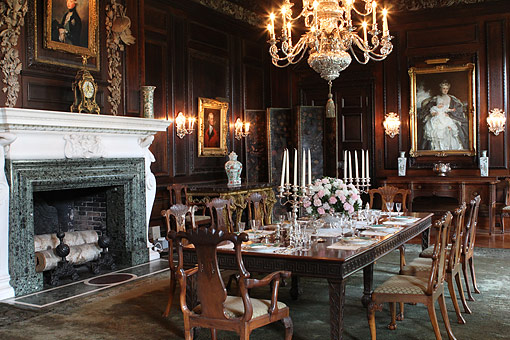 |
| Here's a sample of the shot from which we're cropping below, the dining room of the Westbury House. Though it looks well-illuminated here, it was quite a bit darker than this. |
As you'll see below, the engineers have managed to eke out just a bit more crispness and detail in the Canon 60D than in its already-excellent predecessor. Check our Canon 60D Gallery page and Canon T2i Gallery page for links to both JPEG and RAW versions of these images, as well as another set from a more brightly-lit room. Remember, this is comparing one excellent camera against another at 100 percent onscreen, and unless you print a massive image, you won't see the difference in a print.
Canon 60D versus Canon T2i at ISO 1,600
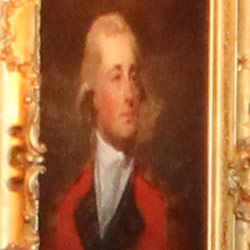 | 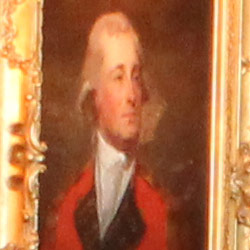 |
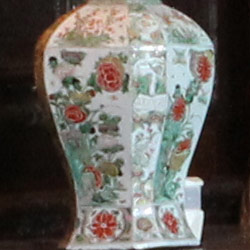 | 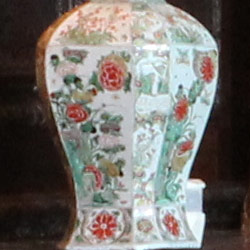 |
| Canon 60D at ISO 1,600 | Canon T2i at ISO 1,600 |
| At ISO 1,600 it's hard to see much difference between the two cameras. The 60D's image on the left looks a little more contrasty, and detail is better defined, but much of that could be due to a slightly lighter exposure. | |
Canon 60D versus Canon T2i at ISO 3,200
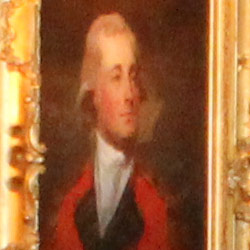 |  |
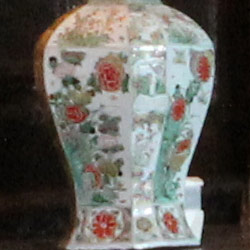 |  |
| Canon 60D at ISO 3,200 | Canon T2i at ISO 3,200 |
| At ISO 3,200 the Canon 60D's black shades are a little better, and reds retain more saturation. Detail in the roses of the vase seems a little better defined. | |
Canon 60D versus Canon T2i at ISO 6,400
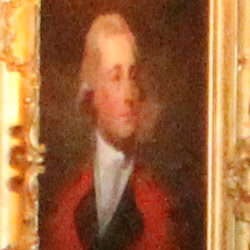 | 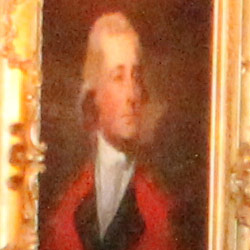 |
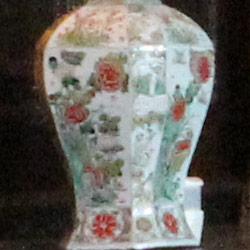 | 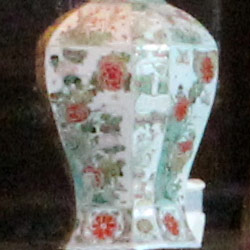 |
| Canon 60D at ISO 6,400 | Canon T2i at ISO 6,400 |
| Slightly more noise is introduced into the image in the brown field behind the gentleman in the portrait, but more contrast and detail are maintained as well, and the gentleman's eyes are more distinct. Some of the T2i's detail in the vase is starting to fade. | |
Canon 60D versus Canon T2i at ISO 12,800
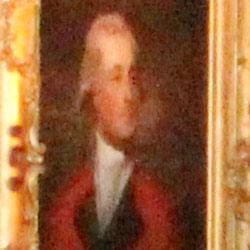 |  |
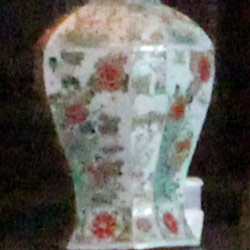 | 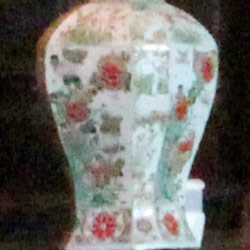 |
| Canon 60D at ISO 12,800 | Canon T2i at ISO 12,800 |
| At ISO 12,800 there's a little more definition in many aspects of the Canon 60D's image, but the continued difference in brightness makes it hard to pick a favorite. The gentleman's eyes are still more distinct in the 60D shot, but I might prefer the T2i's softer rendering at this ISO level. It's a pretty close call. Both cameras handle the scene quite well. | |
Just two years ago, ISO 12,800 was a throwaway setting at best, with the 50D turning out nasty images fraught with overt banding, visible even in a thumbnail. Today I look at ISO 12,800 from the Canon 60D and T2i and have a hard time finding much to comment on. It's impressive. Feel free to shoot in near-darkness.
Movin'. Shot at f/6.3 and 1/250 second, this guy was moving fast from flower to flower. It's not tack sharp, but I'm glad I caught the motion of its wings.
Shooting with the Canon 60D
by Shawn BarnettI left Dave to take pictures inside the hot, non-airconditioned Westbury House, instead wandering out into the Old Westbury Gardens on a very hot day. The good news was that plants love hot days, and the gardens were replete with interesting flowers, birds, and butterflies. Since I knew that I'd only be able to make one pass, I shot primarily with the Canon 60D's kit lens, the EF-S 18-135mm. It's a versatile optic that's well-suited for a walk in the park.
Despite a large number of changes to the Canon 60D's user interface, it was still largely familiar. I have to admit that though I'm disappointed that some functions no longer have a button, I found the control layout very efficient. Pulling up the Quick menu is how you get most things done, using the rear status display. I still habitually changed ISO and Drive modes on the top deck most of the time, but it was a lot easier than it is on my 20D, thanks to the simpler one-button, one-function philosophy.
I also appreciated the smaller size of the Canon 60D. It's not dramatically smaller, but is better for a walk than the 50D was. I don't think it's as small as my now ancient 20D, but I think the grip is smaller, and will be more comfortable for a wider array of users.
Zoom range. Just a quick demonstration of the 18-135mm's range. That's a sun dial on the top of that tower, by the way.
Narrow DOF. Thoroughly enjoyed shooting the freakishly large and bright EF 85mm f/1.2 optic indoors.
Later I went inside the Westbury House and took some shots indoors with the extremely fast (and heavy) EF 85mm f/1.2 lens. The lens was so bright that I chose to dial the EV back by -1.3 to keep the dark look to the rooms, while still maintaining the ridiculously smooth bokeh. At that point I was having more fun with the lens than the camera, but that's testament to how quickly the Canon 60D got out of my way and just let me take pictures, which is what it's all about.
Waddle. I enjoyed watching this family walk away from the rest of the crowd. A photo is good, but I was happy when I remembered I could take a video of them. (Click on the image to download a 52MB file. Note that you'll need a fast processor and a high-res screen to view this Full HD video)
One major item disappointed me about the Canon 60D. I own two lenses that front and back focus by a touch, and I've been waiting for the 60D to come so that I could correct for those problems with the Lens AF Microfocus Adjustment feature that was on the 50D, 7D, and other Canon pro SLRs, but not on the Rebels. Deletion of this feature is a strange choice that I just don't get from Canon's perspective. Yes, it forces more advanced photographers like me to buy a 7D, but not all can afford such a camera. Besides, who doesn't want a way to make their lenses sharper? Wouldn't Canon benefit if people could have their photographer friends show them how to tune their lenses to be even better? It seems like a no-brainer to me, and it should be a pretty easy software fix. To omit it from a high-end camera whose predecessors have the feature just doesn't make sense. Perhaps they don't want to field the support calls when curious newbies find and adjust the feature and suddenly all their pictures are blurry. It's possible.
Aside from that issue, I really enjoyed shooting with the Canon 60D. I like its reduced size, simplified controls, including the new integrated 8-way controller and Quick Control dial. The big 8-way disk allowed me to easily change AF points with a quick press, just like the joystick used to do. I forgot to use the Vari-angle display until I started doing contortions to get the right angle while shooting indoors. It's very nice to have on an SLR. The 18-135mm kit lens is a near ideal lens for their new target market, with reasonable sharpness and a handy 7.5x zoom range, not to mention a pretty solid image stabilization system. Given the high resolution of the Canon 60D I recommend hobbyists consider some sharper optics for more serious work, and a medium prime lens or two.
Ultimately, the Canon 60D is built for a different market. Canon has long since lured many serious 50D shooters to the 7D and 5D Mark II; now it appears their goal is to lure the Rebel shooters to the Canon 60D and more directly compete with the Nikon D90. That's probably just the right strategy. Most of the important features from the 7D and T2i are included in the Canon 60D, as well as the audio level control from the 5D Mark II and the swivel screen from the Canon G11. It seems like every Canon line has contributed a little something to Canon's entry-level prosumer digital SLR, and the results are quite good.
| EOS 60D Black SLR Digital Camera Body Only | ||||
Similar Products: | Shop at | Price | Seller Rating | |
| $999.00 | 10155 Reviews |  | ||
| $999.00 | 10425 Reviews |  | ||
| $999.00 | 1231 Reviews |  | ||
| $999.99 | 6537 Reviews |  | ||
| $919.00 | 362 Reviews |  | ||
| $919.99 | 1358 Reviews |  | ||
| $999.00 | 3263 Reviews |  | ||
| $999.00 | 1528 Reviews |  | ||
| $999.00 | not rated 409 Reviews |  | ||
| $1,199.95 | not rated 1 Review |  | ||
| Compare Prices for All 10 Sellers | ||||
| |
 | Print this Page |
Quantity :
Add to Cart


















No comments:
Post a Comment